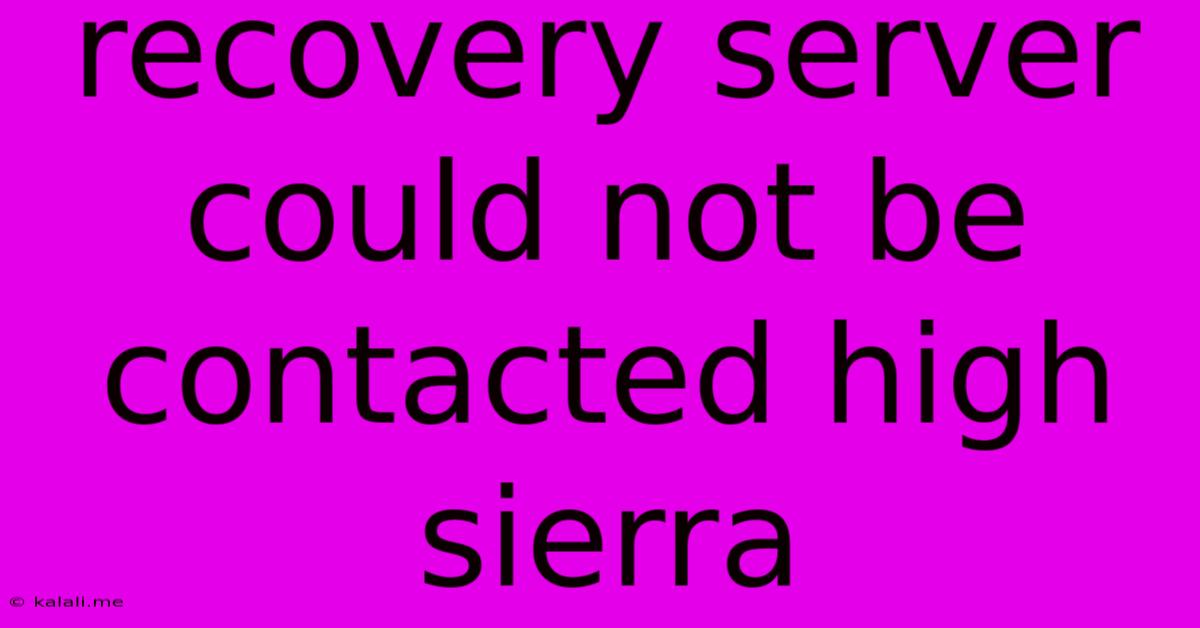Recovery Server Could Not Be Contacted High Sierra
Kalali
Jun 09, 2025 · 3 min read

Table of Contents
Recovery Server Could Not Be Contacted: Troubleshooting High Sierra's Startup Issues
Facing the dreaded "Recovery Server Could Not Be Contacted" error on your High Sierra Mac? This frustrating message prevents access to macOS Recovery, leaving you unable to reinstall the operating system, troubleshoot problems, or restore from Time Machine. Don't worry, this article will guide you through effective troubleshooting steps to get your Mac back up and running. This issue often points to network connectivity problems, but other factors can also contribute.
This article covers troubleshooting steps, potential causes, and alternative recovery methods. We will explore solutions ranging from simple network checks to more advanced recovery options.
Understanding the Error
The "Recovery Server Could Not Be Contacted" error usually appears during the startup process when your Mac attempts to connect to Apple's recovery servers to download necessary files for macOS Recovery. This means your Mac can't access the internet or there is a problem with the recovery system itself.
Troubleshooting Steps: Getting Back to Recovery
Let's tackle the most common causes and their solutions:
1. Network Connectivity Issues:
- Check your internet connection: The most frequent culprit. Ensure your Wi-Fi or Ethernet cable is properly connected and functioning. Try restarting your router and modem.
- Test your network: Use another device (phone, laptop) to verify your internet connection is working correctly. If other devices have internet access, the issue lies with your Mac's network configuration.
- Try a different network: If possible, connect to a different Wi-Fi network or use a wired Ethernet connection to rule out network-specific problems.
2. Hardware Problems:
- RAM issues: Faulty RAM can interfere with the startup process. Try reseating the RAM modules (if you're comfortable doing so). Consult online resources specific to your Mac model for guidance.
- Hard drive problems: A failing hard drive can prevent your Mac from accessing the recovery partition. This requires more advanced troubleshooting and might necessitate professional assistance. Listen for unusual noises coming from your Mac during startup.
- Bootloader issues: The bootloader, responsible for starting up your Mac, could be corrupted. This requires more advanced troubleshooting steps, often involving reinstalling the OS.
3. Software Problems:
- Corrupted system files: Damaged system files can prevent the recovery partition from working correctly. This often requires reinstalling macOS.
- Third-party software interference: In rare cases, third-party startup items or extensions might interfere with the recovery process.
4. Internet-Related Troubleshooting:
- DNS Settings: Incorrect DNS settings might prevent your Mac from reaching Apple's servers. Try using public DNS servers like Google's (8.8.8.8 and 8.8.4.4) or Cloudflare's (1.1.1.1 and 1.0.0.1). You'll need to access your network settings (likely within System Preferences) to change these.
- Firewall Interference: Ensure your firewall isn't blocking access to Apple's servers. Temporarily disable your firewall to see if this resolves the issue. Remember to re-enable it afterwards.
- Proxy Settings: If you're using a proxy server, temporarily disable it to check if it's interfering with the connection.
5. Alternative Recovery Methods (If All Else Fails):
- Internet Recovery (using Command + Option + R): Holding down these keys during startup will attempt to download macOS Recovery from Apple's servers. This requires a working internet connection. This is a last resort when your internal recovery partition is inaccessible.
- Bootable Installer: If you have a bootable macOS installer (created previously), use this to reinstall the operating system.
Prevention Tips
- Regular backups: Perform regular Time Machine backups to protect your data. This way, you can restore your system if necessary without relying solely on the recovery partition.
- Keep your software updated: Regular software updates address bugs and security vulnerabilities that could cause problems.
If you've exhausted these troubleshooting steps and are still unable to resolve the "Recovery Server Could Not Be Contacted" error, it's best to seek professional assistance from an Apple authorized service provider or a qualified computer technician. They can diagnose any underlying hardware or software issues and help get your Mac back to full functionality. Remember to always back up your important data before attempting any major troubleshooting steps.
Latest Posts
Latest Posts
-
Propane Vs Electric Hot Water Heater
Jun 09, 2025
-
Why Does My Truck Shake At High Speeds
Jun 09, 2025
-
Area Of Intersection Of Two Circles
Jun 09, 2025
-
Why Does My Fire Alarm Go Off Randomly
Jun 09, 2025
-
How To Clean Candle Wax Out Of Glass
Jun 09, 2025
Related Post
Thank you for visiting our website which covers about Recovery Server Could Not Be Contacted High Sierra . We hope the information provided has been useful to you. Feel free to contact us if you have any questions or need further assistance. See you next time and don't miss to bookmark.